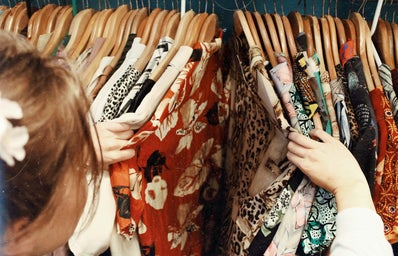One of my favourite ways to spend a Saturday or any rainy afternoon is grabbing a coffee and heading to the closest neighbourhood thrift store. Not only is thrifting a popular pastime amongst Gen Z for its ability to help curate a unique wardrobe, but it also promotes healthy and ethical habits for both your wallet and the environment.
According to Statistics Canada, as of 2021, the average Canadian household spends $2,303 on clothing and accessories per year. Although we can somewhat credit this number to inflation, the trend cycles that pervade our social media feeds are primarily responsible for fashion trends reaching consumers at a rapid rate. Thus, only forcing society’s consumption habits to multiply.
One-stop shopping at department stores or the mall has a way of curing boredom; everything is all in one place, and we can’t help but peruse every store that piques our interest. However, by spending money on trendy pieces that are a product of fast fashion and made from low-quality materials, we increase the likelihood of having to replace each of these items at a faster rate.
As a result, we become susceptible to conspicuous consumption — consuming goods that are unnecessary in practice but enjoyable to purchase. By thrifting, we are less likely to succumb to short-lived micro trends and shop with purpose.
There is something to be said about the thrill of searching through the racks of clothes with your headphones on or with a group of friends, not knowing what unique pieces could be found. It becomes a collaborative activity.
Thrifting encourages individual style, allowing us to find vintage and one-of-a-kind pieces. Even if it’s finding basic wardrobe staples, often the better quality pieces are decades old due to the difference in manufacturing standards. The modern need for fast turnover with little regard for how well the product is made forces brand-new products to have wildly short lifespans.
Beyond what thrifting can do to elevate personal style, you may be wondering what it has to do with the bigger picture.
When buying clothing second-hand, we contribute to the lessening of textile waste that goes into our landfills. Fabrics are not an easy material to decompose, with natural fibres like cotton taking around six months to decompose and manmade materials like polyester taking up to 100+ years.
Despite these pieces collecting dust in our closet for what feels like forever, they have yet to scratch the surface of how long they’ll exist on earth as a pollutant.
Shopping secondhand is often an exclusively in-person activity. However, online thrifting has since become just as popular and a much more accessible way to give a second life to clothing. Although it’s not as size-assured or sustainable as visiting a thrift store in person, the less new clothing we purchase from retailers, the less water, energy, and material are used in garment production and transporting processes, ultimately helping us have a small part in minimizing greenhouse gas emissions.
Maybe one of the most noticeable benefits of thrifting is the sense of community that it brings. Purchasing items from for-profit thrift stores and charitable organizations like Goodwill and the Salvation Army, or even your local church thrift store, helps secure the availability of low-cost clothing for low-income neighbourhoods that rely on it. Companies like these also provide more job opportunities for community members.
Toronto is littered with countless independent vintage stores that curate and seek high-quality pieces that do the work of sorting through options for you, especially if you aren’t in the mood to spend hours at the clothing racks or aren’t sure what you’re looking for. Although they can sometimes be on the pricey side, you know the clothing has been inspected for quality and is in good condition. At the end of the day, supporting small businesses supports the local economy and keeps our city diverse.
Although thrifting is not for everyone, it’s important to know that it’s more than just a fun pastime. Humans crave disposable individuation to the point that it becomes inhumane for workers to produce and for us to consume at a rapid pace. It’s damaging to both the environment and our behaviour. Thrifting an entirely new wardrobe is not realistic; some items are easier to buy new.
Start by finding some fun pieces and work up to changing your staple basics to thrifted items. It can be as simple as switching a shopping trip at Aritzia for one at Value Village once in a while. However, it’s important that when we purchase new garments it’s done with the intention of ensuring they will be worn and used for many years to come.
Don’t know where to start? Here are some of my vintage and thrifting go-tos:
1. Value Village
924 Queen St E, Leslieville, Toronto
It’s one of the smaller Value Village locations in the city, but it’s no less stocked! Every aisle is packed with clothes, decor and books.
2. Value Village (Lansdowne)
1319 Bloor St W, Brockton Village, Toronto
The biggest Value Village location is near the downtown core. I recommend going on a weekday to avoid the busy crowds. It has a great coat and home section!
3. Coffee and Clothing
841 Gerrard St E, Leslieville, Toronto
It’s a little on the expensive side for second-hand clothing but stocks one-of-a-kind pieces. It has a cafe in the front of the shop for your morning coffee and a barbershop in the back. Coffee and Clothing also has a flea market every second Sunday for different vintage and small business vendors.
4. Public Butter
1290 Queen St W, Parkdale, Toronto
Owned by the same people as Black Market, Public Butter is a neighbourhood staple for vintage denim and accessories. They have frequent store-wide sales to look out for.
5. YSM Double Take
310 Gerrard St E, Cabbagetown, Toronto
This is Yonge Street Mission’s employment initiative thrift store. It has affordable prices for home decor, shoes and clothing.
6. Ran’s Closet
322 College St, Kensington Market, Toronto
This is a small vintage store just north of Kensington Market with reasonably priced, high-quality pieces.
7. Vintage Depot
70 Kensington Ave, Kensington Market, Toronto
Vintage Depot is a huge thrift store hidden in Kensington Market that looks unassuming from the outside but has one of the largest collections of vintage clothing in the city.
8. Philistine
928 Queen St W, Trinity-Bellwoods, Toronto
Located on West Queen West, Philistine stocks mainly new clothing, gifts and accessories from well-known brands, but also sources high-quality vintage items as well.


